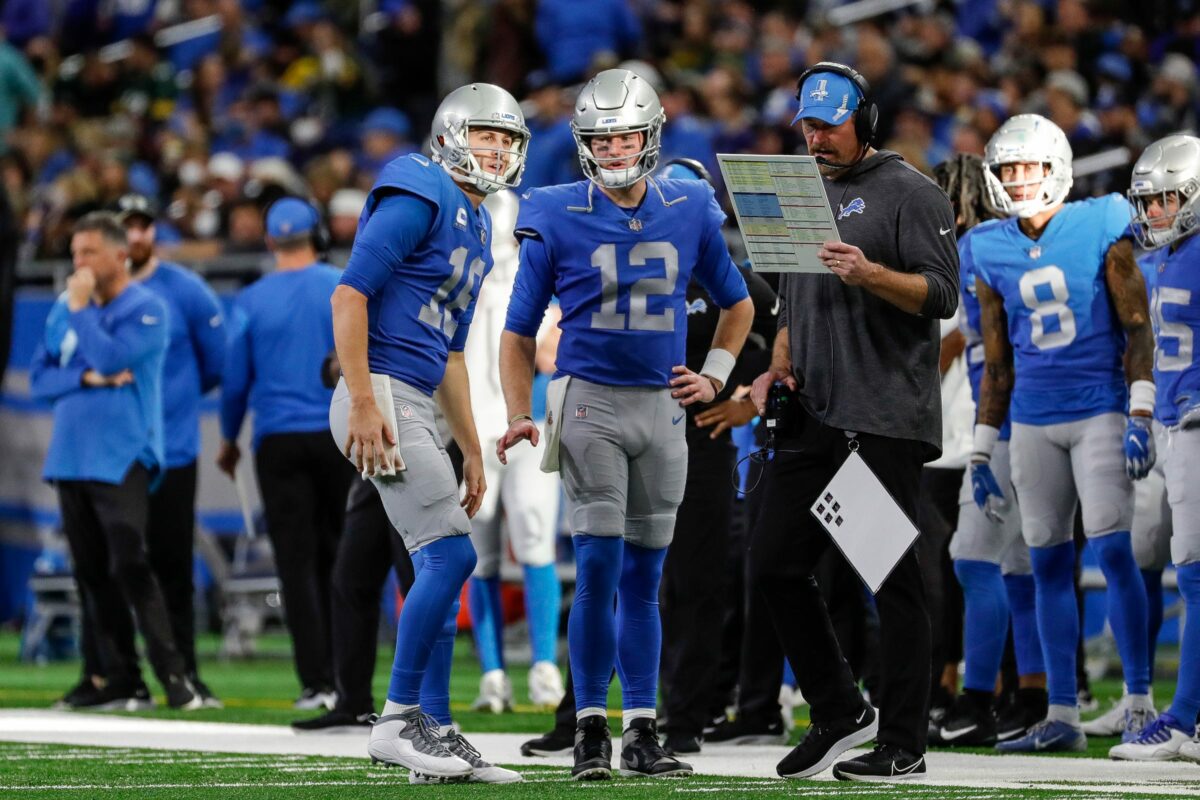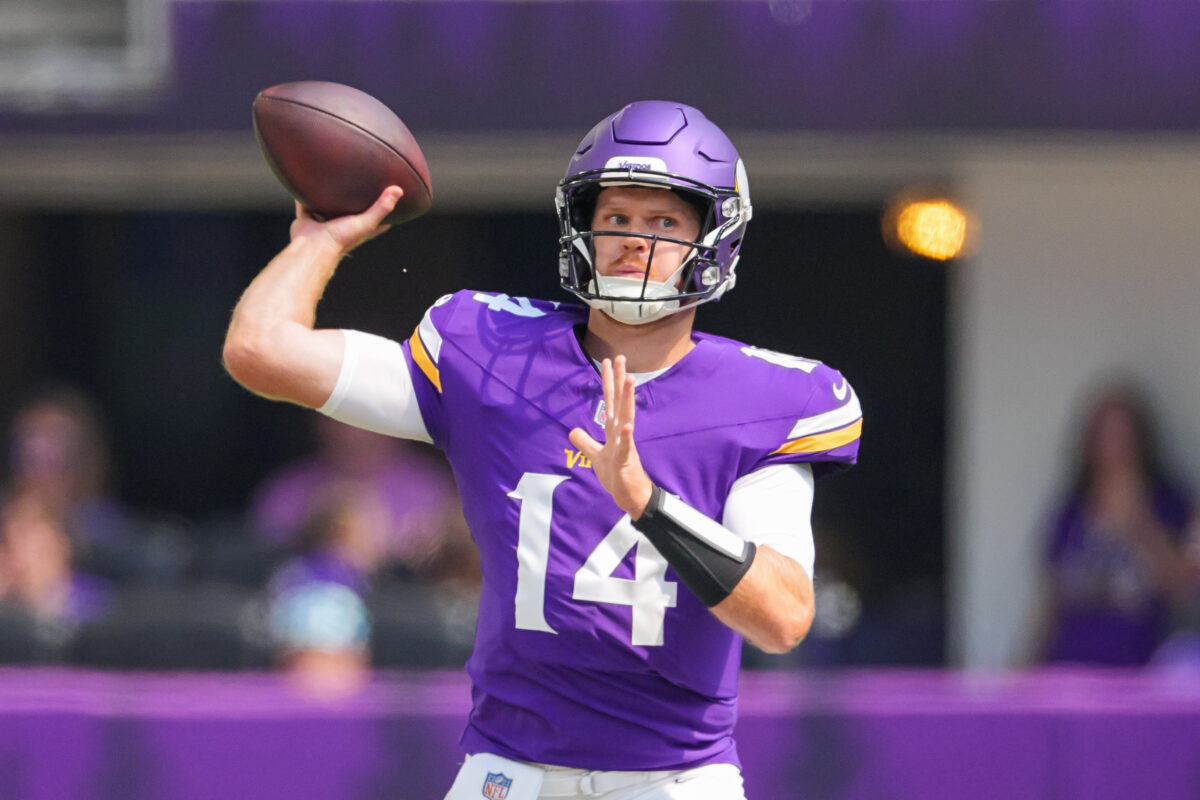Anthony Richardson plays football like a cloned version of Josh Allen. If he can stay healthy after playing just four games as a rookie, he’ll make the Indianapolis Colts one of the most entertaining teams in the NFL.
But he may not be able to make them a playoff team no matter how good he is if his defense can’t match that rise.
Richardson, in an NFL career that has only lasted 173 snaps so far, is generating impressive hype. At +3500 his regular season MVP odds are nestled right behind Justin Herbert and Matthew Stafford. Fantasy gurus love him; Rotowire pegs him as this year’s sixth-ranked quarterback. That’s not an indicator of team success or anything more than the fact he’s expected to be a lightning bolt on the ground and through the air, but it does capture some of the excitement around a player who completed 59 percent of his passes as a rookie.
If he can approach that hype, growing pains aside, he can put Indianapolis in position to challenge the Houston Texans atop the AFC South. But the only way the Colts can usurp CJ Stroud is with a defense that reaches a level beyond mediocrity.
Let’s start with the fun stuff.

Anthony Richardson plays quarterback like someone duct taped an anti-aircraft gun to a monster truck
The Allen comparisons aren’t superfluous. The Bills quarterback came into the league as a bazooka-armed specimen a few pounds shy of being an edge rusher. He struggled with his accuracy but never shied away from big gains through the air or big hits on the ground.
Richardson is, well, all that. At 6-foot-3 and 244 pounds he’s the kind of devastating open field runner defensive backs can’t bring down without ceding extra yardage. And his arm, well…
Laser show.
The Colts used their rookie quarterback often on designed runs, ostensibly designed to lessen the burden of a first year player reading complex defenses. Richardson threw 84 passes in his abbreviated debut but ran 25 times — a 22.9 percent run share that nearly matches Lamar Jackson’s split in his MVP 2023 campaign (148 runs, 457 passes and a 24 percent run share). This led to an efficient 5.4 yards per carry. It also created the conditions that led to Richardson leaving the field with trainers twice — the second time four games into the season and for good.
It will be interesting to see if head coach Shane Steichen allows him to run as often in year two. Richardson’s success rate on the ground — runs that pick up at least 40 percent of yards needed for a first down on first down, 60 percent on second down and 100 percent of yards-to-go on third or fourth down — was 64 percent. Only one regular player in the NFL had a higher number in 2023… Josh Allen at 65.8 percent.
That’s pretty much a cheat code to keep this offense on schedule, but there’s more to Richardson’s arsenal than big runs. He had little issue airing it out as a rookie; 36 percent of his throws went at least 10 yards downfield, a rate higher than Allen’s 34 percent or, if we’re looking at another celebrated first year starter, Jordan Love’s 33 percent. While that contributed to his less-than-stellar completion rate, it also created a roughly league average 6.9 yards per attempt.
Nothing spurs a young quarterback’s growth like a great pass catching corps, and general manager Chris Ballard has put in work to make that happen. Michael Pittman’s value as a reliable possession receiver worked out to $70 million over three years, per his recently signed contract extension. Josh Downs, who clicked with Gardner Minshew in stretches as a rookie, is there to work the slot. Alec Pierce remains a viable deep option.
But the key may be the Colts’ 2024 second round selection. Adonai Mitchell wasn’t a model of consistency at Georgia and then Texas, but he showed up in big moments to elevate both teams. More importantly, he has all the tools to shed coverage at the next level; size (6-foot-2, 205 pounds), speed (4.34 second 40-yard dash time) and that preternatural sense that helps him level up in the biggest moments (touchdown receptions in every College Football Playoff game he ever played).
If Mitchell can expand his route tree and do a little bit of everything, it’s going to make everyone’s lives easier. That’s asking a lot, however. What would be an easier lift is if Jonathan Taylor can return to All-Pro status.
Taylor has yet to revisit the heights of his league-leading 2021 season or even his rookie 2020. Injuries have cost him 13 games the last two years and after averaging 5.3 yards per carry his first two seasons he’s down to 4.4 since. His success rate hasn’t broken 50 percent either of the last two years. He’s still good, but good wasn’t what he showed us when he entered the league.
If he can be the stable presence churning yards and setting up third-and-short, it would take the onus off Richardson’s legs, allow him to take fewer hits and create the space to turn his shotgun blasts downfield into sniper fire. But the Colts can survive any sophomore struggles if their defense rises to the occasion.

The Indianapolis defense is (mostly) running it back and hoping for the best
Ballard’s big moves this offseason mostly involved keeping the band together. This spring, he re-signed:
- LB Zaire Franklin
- CB Kenny Moore
- S Julian Blackmon
- DL DeForest Buckner
- CB Darrell Baker Jr.
- DT Grover Stewart
- EDGE Tyquan Lewis
and more. The team’s free agency page on Over the Cap is a sea of blue sticking with blue, with few exceptions.

There are good players here, no doubt, but it leaves the heavy lifting of improving a middling-to-bad defense on the development of young prospects. The Colts ranked 28th in points given up last season, though that doesn’t tell the full story. They were 20th in defensive DVOA and 19th in expected points added (EPA) allowed.

One of the 2023 Colts’ hallmarks was generating chaos without blitzing. Indianapolis’ 15.7 percent blitz rate was the lowest in the league. Even so, the team’s 51 sacks were a top five mark. This defense didn’t generate a ton of pressure (19.6 percent, 22nd in the NFL) but made sure it finished the job when given the chance.
Laiatu Latu, the first defensive player taken in this year’s draft, fits that mold perfectly. He was one of college football’s most productive pass rushers after 23.5 sacks and 34 tackles for loss in 25 games as UCLA. But he’s also the only rookie the Colts selected before the fifth round. Raekwon Davis, the team’s highest-profile new arrival in free agency, projects as a rotational interior lineman who is much more of a big-bodied lane clogger than pass rusher (17 credited pressures in four NFL seasons).
The rookie @laiatu_latu gets home 😤#INDvsCIN on Prime Video
Also stream on #NFLPlus pic.twitter.com/fa4u5s0tMy— NFL (@NFL) August 23, 2024
If that front can’t make the most of its pressure like last season, it’s going to turn up the heat on a young secondary. Re-signing Moore was a no brainer, and he’ll provide steady veteran coverage over the slot. Along the sidelines, Steichen will be trusting recent draftees JuJu Brents and Jaylon Jones, each of whom showed flashes as rookies but ultimately recorded passer ratings in the 99s when targeted last fall. While the Blackmon/Nick Cross combination is a viable pass/run deterrent, this remains a group liable to struggle through growing pains.
***
Ultimately, how the Colts react to those growing pains will define their 2024. Richardson has to prove he’s more than just fantasy fodder. The team’s secondary has to prove it can handle increased reps if its pass rush can’t finish the job. Mature quickly and make the playoffs. Develop at a more reasonable rate and that dream defers for another season.
That’s fine, and the excitement will follow whenever Richardson is in the lineup regardless. Indianapolis bet hard on its internal development this offseason, hoping last year’s nine-win campaign with Gardner Minshew behind center could be the foundation for something more. That’s a logical move — and one that puts a lot of trust in Shane Steichen’s staff in his second year on the job.
[lawrence-auto-related count=3]
































